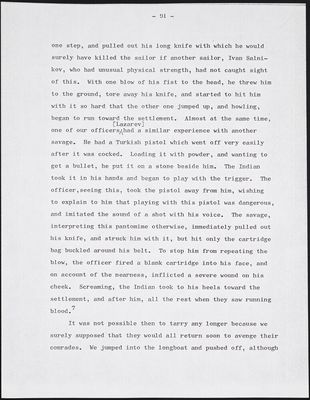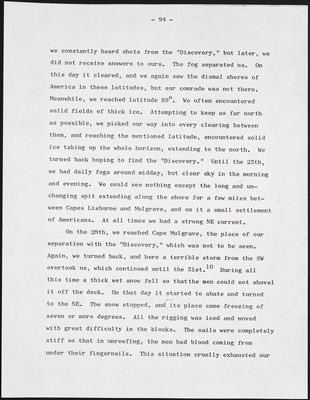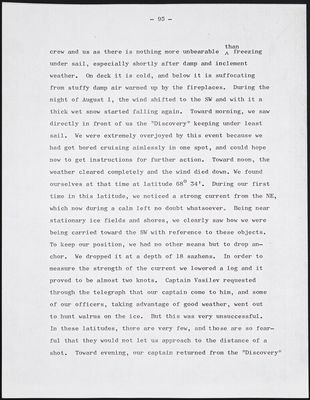Pages
mss142-vasilevShishmarev-i3-041
– 91 –
one step, and pulled out his long knife with which he would surely have killed the sailor if another sailor, Ivan Salnikov, who had unusual physical strength, had not caught sight of this. With one blow of his fist to the head, he threw him to the ground, tore away his knife, and started to hit him with it so hard that the other one jumped up, and howling, began to run toward the settlement. Almost at the same time, one of our officers [Lazarev] had a similar experience with another savage. He had a Turkish pistol which went off very easily after it was cocked.Loading it with powder, and wanting to get a bullet, he put it in a stone beside him. The Indian took it in his hands and began to play with the trigger. The officer, seeing this, took the pistol away from him, wishing to explain to him that playing with this pistol was dangerous, and imitated the sound of a shot with his voice. The savage, interpreting this pantomime otherwise, immediately pulled out his knife, and struck him with it, but hit only the cartridge bag buckled around his belt. To stop him from repeating the blow, the officer fired a blank cartridge into his face, and on account of the nearness, inflicted a severe wound on his cheek. Screaming, the Indian took to his heels toward the settlement, and after him, all the rest when they saw running blood.7
It was not possible then to tarry any longer because we surely supposed that they would all return soon to avenge their comrades. We jumped into the longboat and pushed off, although
mss142-vasilevShishmarev-i3-042
--92--
the water was still rising. We had succeeded rowing out not far from shore when all the Indians appeared on it and sent into us a whole cloud of arrows, which, however, caused no harm whatsoever because we protected ourselves with walrus skins traded from St. Lawrence islanders. We did not respond to their shots and only tried to get away from their shots. But when they started to shoot from guns, and the bullets began piercing the skins, the captain ordered us to fire a falconet ball over their heads. Hearing the whistle of the ball, they quieted down for an instant, but soon, raising a horrible cry, shot arrows and bullets at us again, and dashed toward their baidars, pushing them into the water in order to pursue us. Then the captain ordered us to aim the falconet at the largest of them. The cannon fired, and the ball ripped out the entire side of the baidar wounding one man. They then abandoned further attempts to attack us, and retreated to their abodes. We also left them in peace, and with the changed current, arrived safely on the sloop after three hours.8
The "Discovery" was still not there, but we started immediatey to get ready for the further journey, that is, lifted the longboat and filled empty barrels with water from a spring on Chamisso Island.
On July 16 at 7 o'clock in the morning, we sighted our sloop going toward the island. It stopped in the outer part of the bay. Immediately we lifted anchor, and crossing the strait, dropped it again beside it. At four o'clock in the
mss142-vasilevShishmarev-i3-043
– 93 –
afternoon, and American brig [the Pedler entered the bay and dropped anchor not far from us. Its captain by the name of Piget [Pigot] boarded the "Discovery." He announced that he had come here from the Sandwich Islands to trade furs with the local inhabitants. We advised him to go to the smaller part of the Sound, and, at that, as close as possible to the northeastern shores, but not to go on land, and to permit the Indians on the brig only after taking all precautions because these people were crafty and wicked. As proof, we related our adventures with them, and advised him of the principal article that they required. After nine months we met him again on Vahu Island [Oahu] and learned that he had a profitable trade following our advice.9
Sailing northward from Kotzebue Sound
On July 17, we weighed anchor, and on the 18th, passing Cape Krusenstern, we set out toward the North. About noon, a thick descending fog hid the "Discovery" and the shore from us. Then we started to give each other fog signals every quarter of an hour. Toward evening the fog lifted, and we again saw the "Discovery" and the shore. The latter was so close that we saw on it with the naked eye a large settlement, from which came down to the shore a large number of inhabitants, who waved fox and other furs at us. But we, not paying any attention to them, continued our trip in the stated direction. The clear weather did not remain long. After midnight the fog thickened again and persisted uninterruptedly until the 22nd. At first,
mss142-vasilevShishmarev-i3-044
– 94 –
we constantly heard shots from the "Discovery," but later, we did not receive answers to ours. The fog separated us. On this day it cleared, and we again saw the dismal shores of America in these latitudes, but our comrade was not there. Meanwhile we reached latitude 69°. We often encountered solid fields of thick ice. Attempting to keep as far north as possible, we picked our way into every clearing between them, and reaching the mentioned latitude, encountered solid ice taking up the whole horizon, extending to the north. We turned back hoping to find the "Discovery." Until the 25th, we had daily fogs around midday, but clear sky in the morning and evening. We could see nothing except the long and unchanging spit extending along the shore for a few miles between Capes Lisburne and Mulgrave, and on it a small settlement of Americans. At all times we had a strong NE current.
On the 28th, we reached Cape Mulgrave, the place of our separation with the "Discovery," which was not to be seen. Again, we turned back, and here a terrible storm from the SW overtook us, which contined until the 31st.10 During all this time a thick wet snow fell so that the men could not shovel it off the deck. On that day it started to abate and turned to the NE. The snow stopped, and in its place came freezing of seven or more degrees. All the rigging was iced and moved with great difficulty in the blocks. The sails were completely stiff so that in unreefing, the men had blood coming from under their fingernails. This situation cruelly exhausted our
mss142-vasilevShishmarev-i3-045
– 95 –
crew and us as there is nothing more unbearable than freezing under sail, especially shortly after damp and inclement weather. On deck it is cold, and below it is suffocating from stuffy damp air warmed up by the fireplaces. During the night of August 1, the wind shifted to the SW and with it a thick wet snow started falling again. Toward morning, we saw directly in front of us the "Discovery" keeping under least sail. We were extremely overjoyed by this event because we had got bored cruising aimlessly in one spot, and could hope now to get instructions for further action. Toward noon, the weather cleared completely and the wind died down. We found ourselves at that time at latitude 68° 34'. During our first time in this latitude, we noticed a strong current from the NE, which now during a calm left no doubt whatsoever. Being near stationary ice fields and shores, we clearly saw how we were being carried toward the SW with reference to these objects. To keep our position, we had no other means but to drop anchor. We dropped it at a depth of 18 sazhens. In order to measure the strength of the current we lowered a log and it proved to be almost two knots. Captain Vasilev requested through the telegraph that our captain come to him, and some of our officers, taking advantage of good weather, went out to hunt walrus on the ice. But this was very unsuccessful. In these latitudes, there are very few, and those are so fearful that they would not let us approach to the distance of a shot. Toward evening, our captain returned from the "Discovery"




